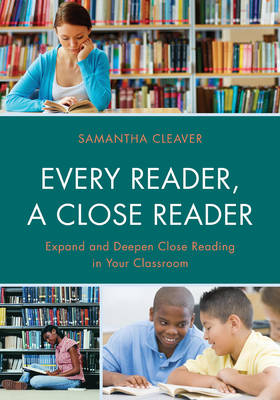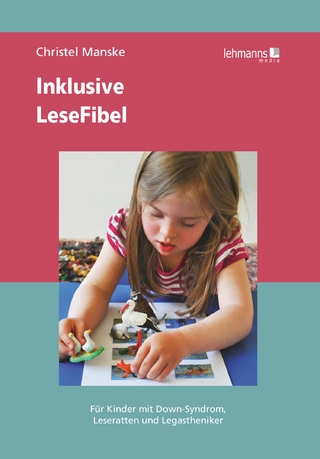
Every Reader a Close Reader
Rowman & Littlefield (Verlag)
978-1-4758-1474-3 (ISBN)
Samantha Cleaver has worked in education for more than a decade as a special education teacher and instructional coach. As a coach, Cleaver has worked with middle grade teachers and school leaders to focus and strengthen reading instruction.
Contents
Acknowledgments
About the Author
Foreword
Introduction
·Close Reading: The Best Reading You Can Do
·Reading Theory: A Brief History
·Close Reading and the Middle School Reader
·Every Reader a Close Reader Overview
oIn This Book
oUsing This Book
·WeAreTeachers Survey
·Getting Started: Understanding Yourself as a Reader
Chapter 1: Close Reading and the Common Core
·Introduction to the Common Core State Standards
oKey Points
·Using the Common Core ELA Standards
·Close Reading and the Common Core
oKey Points
·What’s Different? The Shifts in the Common Core
oShift 1: Balancing Informational and Literary Text
§Shift 1: Implications for Close Reading
oShift 2: Knowledge in the Disciplines
§Shift 2: Implications for Close Reading
oShift 3: The Staircase of Complexity
§Shift 3: Implications for Close Reading
oShift 4: Text-Based Answers
§Shift 4: Implications for Close Reading
oShift 5: Writing From Sources
§Shift 5: Implications for Close Reading
oShift 6: Academic Vocabulary
§Shift 6: Implications for Close Reading
oKey Points
·Writing Close Reading Objectives
oKey Points
·Next Step: Getting Ready to Read
Chapter 2: Getting Complex: Selecting and Using Close Reading Texts
·Reading Complex Texts: A Gatekeeper Skill
oKey Points
·Defining Text Complexity
oQuantitative Measures
oQualitative Measures
oInterpretive Complexity: Reader and Task Considerations
oKey Points
·Planning to Use Complex Texts
oSelecting Perfect Passages in Literature
oSelecting Perfect Passages in Informational Text
oChoosing Multiple Texts
oKey Points
·Gaining Purpose
Chapter 3: Setting the Stage: Welcome Students to Text and Set a Purpose for Reading
·The Purpose Behind the Purpose
oKey Points
·Welcoming Students to The Text: A Case for Frontloading
oKey Points
·Using Questions to Set a Purpose for Reading
oCreating Text-Based Essential Questions
§Questions
§Statements
§Should Questions
oKey Points
·Purpose Setting to Dig Deep
oFirst Reading: Comprehension Seeking
oSecond Reading: Analyze the Text
oThird Reading: Digging Deeper
oKey Points
·Making Every Reading Purposeful
Chapter 4: Talking to Text: Enhance Student Comprehension through Text-Dependent Questions and Annotation
·Crafting Text-Dependent Questions
oKey Points
oCreating Sequences of TDQs
oKey Points
·Annotation: Talking to Text
oKey Points
·Citing Text
oQuotations
oParaphrasing
oKey Points
·Citing Evidence from Multiple Texts
oKey Points
·Using Text Evidence
Chapter 5: Applying Close Reading: Create Dialogue and Craft Arguments
·Logic, Evidence and Critical Thinking: Defining Argument
oKey Points
·Crafting Argument
oLogos, Ethos, and Pathos
oKey Points
·Dialogic Discussion
oKey Points
oFacilitating Discussion
oSetting Norms for Discussion: Accountable Talk
oKey Points
·Writing Argument
oKey Points
·Building Student Ownership
Chapter 6: Letting Students Lead: Create Ownership over Close Reading
·Transfer of Close Reading Skills
oKey Points
·Identifying Student Strengths
oKey Points
·Applying the Gradual Release Model to Close Reading
oKey Points
·Getting Specific: Releasing Various Aspects of Close Reading
oStudent-Selected Texts
oStudent-Created Questions
oIndependent Annotation
oStudent-Led Discussion
·Building the Foundation
Chapter 7: Leveling the Field: Empower Struggling Readers with Close Reading
·The Common Core and Special Education
oProvide Multiple Means of Representation
oProvide Multiple Means of Action and Expression
oProvide Multiple Means of Engagement
oKey Points
·Understanding Why Students Struggle with Close Reading
oKey Points
·Planning and Leading Close Reading Lessons for Struggling Readers
oWorking with Complex Text
§Accessing Complex Text in the General Education Classrom
§Accessing Complex Text in the Resource Classroom
oQuestioning
oInteracting with Text: Annotation and Citing Text Evidence
oDiscussion and Writing
·Leveling the Playing Field
Chapter 8: Engage English Language Learners in Close Reading
·English Language Learners and Close Reading in the Common Core
oLearning Academic Vocabulary
oEngaging in Higher Order Thinking
oOpportunities to Interact
oKey Points
·Strategies to Plan and Lead Close Reading with English Language Learners
oWorking with Text
oQuestioning and Citing Text Evidence
oParticipating in Discussion
oArgument Writing
·Close Reading with ELLs
Chapter 9: Raise the Bar: Challenging High-Achieving and Gifted Learners in Close Reading
·Gifted Students, the Common Core, and Close Reading
oThe Common Core and Gifted Students
oA Framework for Gifted Students
oKey Points
·Planning and Leading Close Reading for Gifted Learners
oWorking with Complex Text
oReading (and Rereading) for Purpose
oParticipating in Discussion
oWriting Argument
oExecutive Functioning
·Keeping Close Reading a Challenge
Chapter 10: The Ultimate Question: Assessing Close Reading
·Developing Effective Formative Assessment
oQuestioning
oObservation
oWriting
oKey Points
·Using Formative Assessment Information
oGiving Effective Feedback
§Deep Feedback
§Impression Feedback
oKey Points
·Summative Assessment
oUsing Rubrics
oClose Reading and Standardized Tests
oKey Points
A Worthwhile Task
Appendix A: The MDR/WeAreTeachers Close Reading Survey
·Planning and Text Selection
·Setting a Purpose for Reading
·Annotation and Working with Text
·Respondent Demographics
Appendix B: Literature for Close Reading in Middle School
·Works of Literature: Novels
·Works of Literature: Short Stories
·Works of Literature: Poetry
·Picture Books for Middle School Readers
·Nonfiction: Books
·Nonfiction: Articles and Shorter Texts
·Nonfiction: Primary Sources
Appendix C: Lesson Plans
·Lesson Plan 4.1: Declaration of Sentiments
·Lesson Plan 4.2: Letters between John and Abigail Adams
·Lesson Plan 7.1: 6th Mass Extinction
·Lesson Plan 8.1: Oranges by Gary Soto
Appendix D: Additional Tools
·Tool 1.1: Common Core Shifts: Self-Assessment
·Tool 2.1: Planning for Levels of Complexity in Text
·Tool 3.1: Survey: Why do Students Read?
·Tool 4.1: Annotation Self-Reflection
·Tool 5.1: Assess Students’ Argument Skills
·Tool 5.2: Dialogic Classroom Rating Scale
·Tool 5.3: Argument Writing Foldable
·Tool 6.1: Assess Student Readiness
·Tool 6.2: Assess Student Strengths
·Tool 6.3: Student Discussion Rating Scale
·Tool 7.1: Struggling Reader Needs Assessment
·Tool 8.1: ELL Needs Assessment
·Tool 9.1: Gifted Student Needs Assessment
·Tool 10.1: Format for a Dual Feedback Form
References
Index
| Verlagsort | Lanham, MD |
|---|---|
| Sprache | englisch |
| Maße | 177 x 253 mm |
| Gewicht | 526 g |
| Themenwelt | Schulbuch / Wörterbuch |
| Sozialwissenschaften ► Pädagogik ► Schulpädagogik / Grundschule | |
| ISBN-10 | 1-4758-1474-7 / 1475814747 |
| ISBN-13 | 978-1-4758-1474-3 / 9781475814743 |
| Zustand | Neuware |
| Haben Sie eine Frage zum Produkt? |
aus dem Bereich


